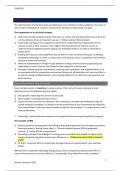Summary
Samenvatting Strategic Management
- Course
- Institution
Beste, Met dit document weet je exact wat te leren voor het vak Strategic Management. Het is heel gestructureerd, dus je gaat er door heen vliegen ;) Veel succes! Maxine Vermeiren
[Show more]



